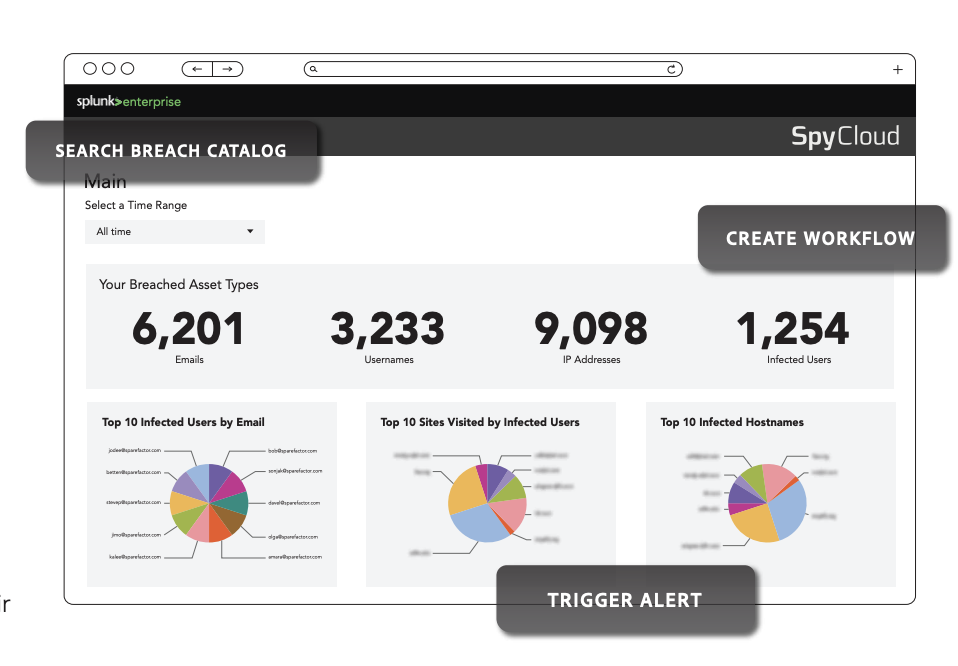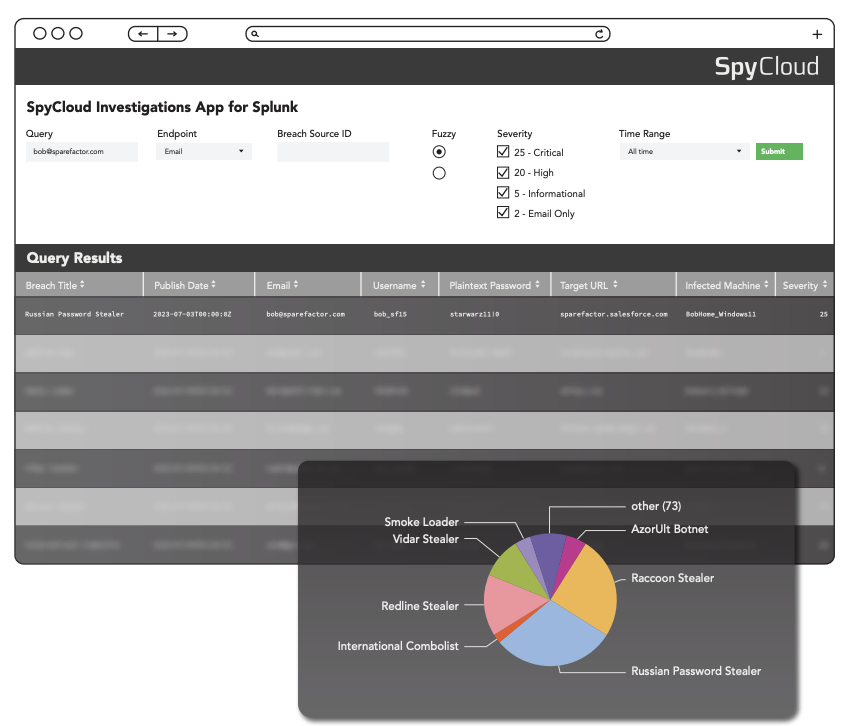Splunk SIEM
For SpyCloud Enterprise Protection.
🧩 Enterprise Protection for Splunk (SIEM)
Bring SpyCloud’s recaptured darknet exposure data – from breaches, malware-infected devices, and successful phishing – into Splunk to accelerate investigation and response for ATO, session hijacking, and ransomware precursors.
Integration page: https://spycloud.com/products/integrations/splunk/
🚀 What you get (at a glance)
- Direct ingest of SpyCloud breach / malware / phished exposure data into Splunk
- End-to-end visibility from identity exposure to actions in your IR workflow
- Actionable alerts that prioritize high-severity signals (e.g., plaintext credentials, malware-sourced cookies/tokens)
- Ticketing & automation handoff from Splunk to your SOAR / ITSM for rapid remediation
Outcome: better signal on the who (identity) and the what (credentials, cookies, tokens) – with faster, measurable time-to-response.
🧭 Quick start
- Install / configure the SpyCloud integration in Splunk.
- Connect your SpyCloud API key to begin ingesting breach / malware / phished exposures.
- Search & visualize exposure events; validate ingestion with dashboards.
- Create detections for fresh exposures and high-risk artifacts.
- Automate: trigger SOAR/ITSM flows (reset credentials, revoke sessions, notify users).

🔎 Investigate & act on real evidence
Spend time on actionable alerts by focusing on the highest-risk signals:
- Plaintext or previously exposed credentials (reuse/variations)
- Malware-sourced artifacts (cookies, tokens) that enable session hijacking
- Phished accounts that require immediate resets or re-auth
Use Splunk to:
- 🔍 Query SpyCloud exposures for your domains/time windows
- 🧩 Correlate with internal telemetry (IdP, EDR, VPN, proxy, HRIS)
- 📝 Auto-generate tickets for breached/malware/phished records
- 🔁 Reset fuzzy/variation matches that attackers can easily guess
🛠️ How it works (expand)
1) Ingest – scheduled import into Splunk
Bring SpyCloud exposure records from breaches, malware infections (infostealer logs), and phished credentials into Splunk on a cadence that fits your ops.
2) Search & Correlate – make identity signals operational
Build searches and saved queries that tie SpyCloud identity evidence to your environment (hosts, users, SaaS apps) to isolate high-risk users quickly.
3) Detect – create detections for high-impact events
Trigger alerts for new exposures, plaintext credentials, malware-sourced sessions, and phished accounts. Prioritize by severity and artifact type.
4) Automate – handoff to SOAR / ITSM
From Splunk, push incidents to your SOAR or ITSM to reset credentials, revoke sessions, force re-auth, disable accounts, and notify end-users/admins.

📊 Dashboards & validation
Use the provided visuals (or build your own) to:
- Confirm data ingestion is healthy
- Track exposure trends over time
- Monitor high-priority threats and remediation throughput

✅ Results you can expect
- Higher-fidelity detections for identity-based threats sourced from breach / malware / phished data
- Faster, automated response via SOAR/ITSM handoff (resets, revocations, re-auth, disable)
- Reduced exposure window and clearer evidence paths for IR and compliance
Updated 2 months ago